Interview: In Defence Of Stinky Martin aka Smrdljivi Martin
November 12, 2020 - Named after St. Martin's Day, when we most often encounter them, the bug known as Stinky Martin aka Smrdljivi Martin has a bad reputation. But, according to Lucija Šerić Jelaska, a doctor in the Biology Department of the Faculty of Science at the University of Zagreb, such a reputation is undeserved.
So usually pleasant is the weather in Croatia that it's not uncommon for home windows to be flung open in spring and rarely closed again until mid-late autumn. When we finally do so, we're looking to escape the increasingly chilly conditions outside. We're not the only ones who want to come in from the cold.
Some animals hibernate over winter, others just seek somewhere a little more sheltered. In autumn, a few spiders and insects can unwittingly enter homes through open windows on their search. Named after Saint Martin's Day, which takes place on 11th November, Stinky Martin aka Smrdljivi Martin is the most discourteously named bug to do so.
“Stinky Martin aka Smrdljivi Martin belongs to a family known as stink bugs or shield bugs,” explains Lucija Šerić Jelaska PhD to TCN. Lucija is a doctor of science who works as a researcher in the Biology Department of the Faculty of Science at the University of Zagreb. “They all have glands that produce a pungent or unpleasant spray when disturbed or threatened. It's a form of protection from predators.”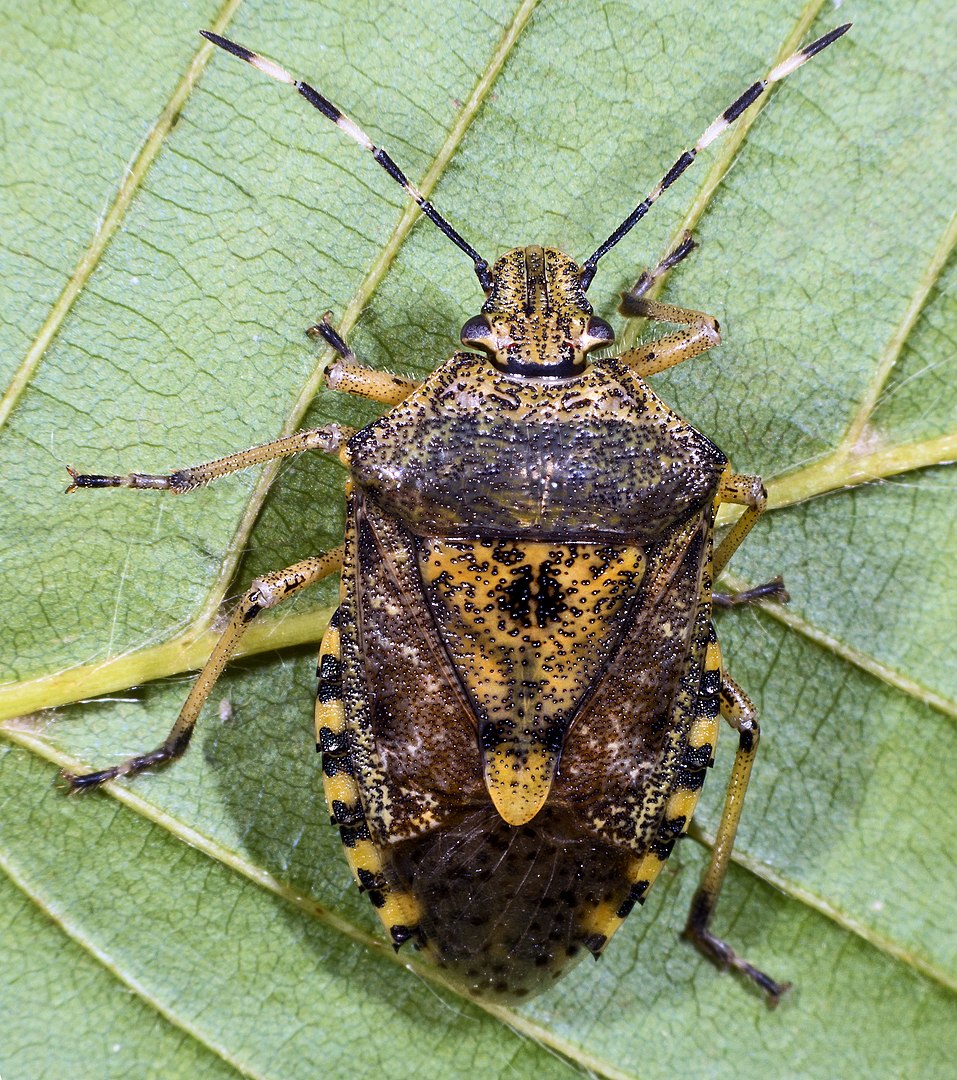 Smrdljivi Martin © Didier Descouens
Smrdljivi Martin © Didier Descouens
“It is not a species specific to Croatia - Smrdljivi Martin is just the common name here for a bug that is found all over Europe,” says Lucija of Rhaphigaster nebulosa (Latin) or the Mottled Shieldbug (English common name). “They like warm and humid climates and so, in winter, they go looking for places to escape the cold. Sometimes it's leaf litter. Other times, it can be the cellars of buildings or people's homes. Around Saint Martin's Day it's becoming colder and so we come into contact with Stinky Martin aka Smrdljivi Martin more often, but actually, they are around outside all the time.”
Insects are unwelcome guests in our homes. But, despite their ghastly name, Stinky Martin aka Smrdljivi Martin are relatively harmless. They move quite slowly. They also fly slowly and clumsily, emitting a low humming noise when they do. They can easily be caught and removed from the home. They can be kept from entering by the same nets we use to keep out mosquitoes, or by closing the windows in our cellars. And yet, perhaps because of their memorable name, mentioning them or catching sight of the often produces the screwing up of faces in disgust.
“Well, they are not beautiful like butterflies or big, shiny, colourful beetles,” laughs Lucija, “and the smell doesn't help. But, they are not considered a pest. When they group together in large numbers, then they can be a pest. People don't like to see them in their orchards or gardens because they can damage the fruit.”
“They mostly feed on plants. The have a long, piercing mouthpart which they use to suck sap from plants. The scars they leave on some fruits by doing this can be attacked by fungi and that can ruin the fruit.”
The defensive spray of Stinky Martin aka Smrdljivi Martin can easily be avoided and, truth be told, aside from very rare and minor allergic reaction, it's not much of a bother if it does catch you. You can simply wash it off, change your clothes. And the smell really isn't that bad.
“Winemakers don't like stinky bugs,” explains Lucija, detailing the few who can be most detrimentally affected by Stinky Martin aka Smrdljivi Martin. “They can hide between the leaves and even the grapes. If enough of them enter the wine production, that wine can have a strange smell and flavour because the bugs contain chemicals like aldehydes and alkynes, sometimes even cyanides which pollute it.”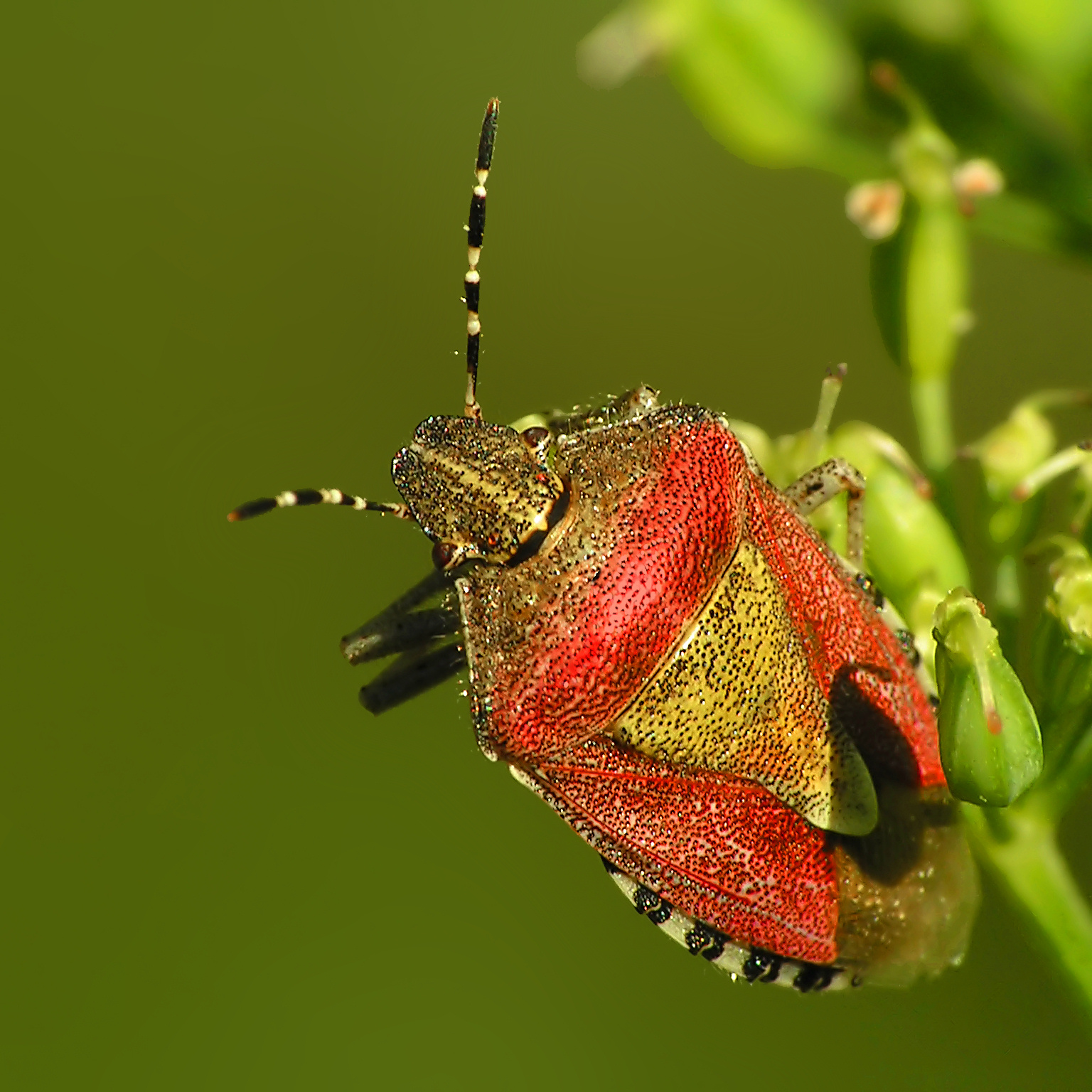 "Smrdljivi Greta is another European shield bug species common to this area and also in Asia. You can find it in hedgerows, fields, parks, gardens. I don't actually know how she got the common name Greta. Unlike Martin, who is a rather dull brown in colour, Greta's colour can be quite bright and variable. It is usually a reddish-purple. I'm speculating, but maybe it was given a female name because of the colour and it was supposed this bug was a female counterpart to Smrdljivi Martin? Of course, they cannot consummate such a relationship - although similar in appearance, they are different species." Photo © Dominik Stodulski
"Smrdljivi Greta is another European shield bug species common to this area and also in Asia. You can find it in hedgerows, fields, parks, gardens. I don't actually know how she got the common name Greta. Unlike Martin, who is a rather dull brown in colour, Greta's colour can be quite bright and variable. It is usually a reddish-purple. I'm speculating, but maybe it was given a female name because of the colour and it was supposed this bug was a female counterpart to Smrdljivi Martin? Of course, they cannot consummate such a relationship - although similar in appearance, they are different species." Photo © Dominik Stodulski
Despite not being welcomed by homeowners and cultivators, Stinky Martin has been here probably for longer than humans have. “They are a natural part of our ecosystem,” says Lucija, defending the bug's residency. “They are food to predators that feed on bugs, such as birds, spiders, some amphibians and other insects. The insects that feed on stinky bugs can be important in biological control, because of the other pests they feed on. Stinky bugs don't necessarily just eat the plants we like either. They could have a role to play in regulating the population of some weed plants.”
The most annoying encounter we regularly have with Stinky Martin aka Smrdljivi Martin at this time of year is on the washing line. Woe betide anyone who leaves freshly washed bedsheets to dry overnight outside in November. Depending on where you live, by the morning, many shield bugs could have crawled between the layers of your sheets, looking for shelter. If you're a bit squeamish, they can make for an awful surprise when appearing in larger numbers. However, if that's something you have seen, you probably shouldn't blame Stinky Martin.
“Those are very likely not Smrdljivi Martin,” explains Lucija. “They simply do not exist in such numbers to be able to invade our homes and lives like the bugs that you and I must remove from the sheets on our washing lines. There is a newcomer that has been causing problems across Europe over the last few years. It is an invasive brown marmorated stink bug, originally native only to Asia. It strongly resembles Smrdljivi Martin. But, there is a big difference. Smrdljivi Martin is a native species. It has been part of our ecosystem for thousands of years. It has natural predators and parasites which control its population.”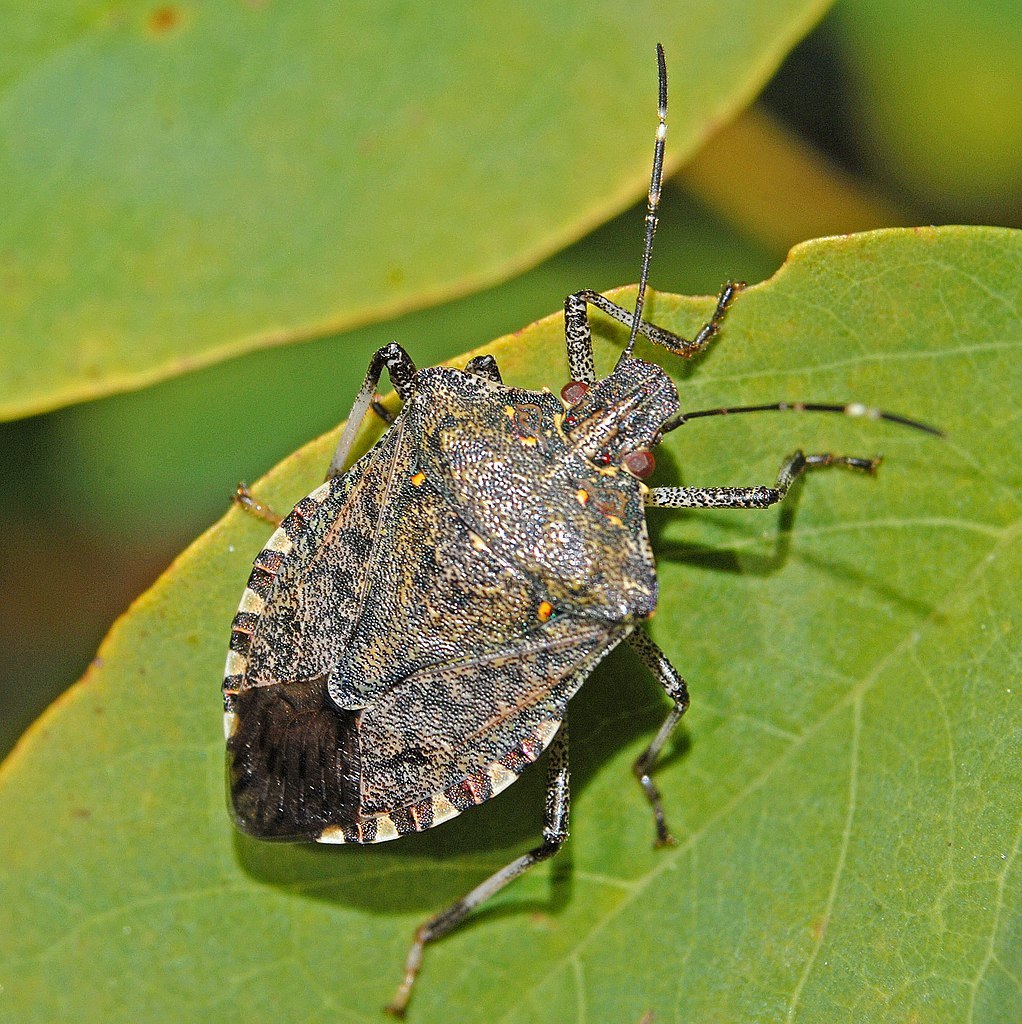 The unwelcome invader, a brown marmorated stink bug, often mistaken as Stinky Martin © Hectonichus
The unwelcome invader, a brown marmorated stink bug, often mistaken as Stinky Martin © Hectonichus
“I first became aware of it when one of my students, Ivan Šapina, noticed them in a cellar in Rijeka in the winter of 2017. He brought it to me, we identified it and wrote a paper about it. The following spring, they were all over Croatia. As a newcomer, it simply does not have the predators and parasites here that has been regulating Smrdljivi Martin over many years in our balanced ecosystem. They now greatly outnumber Smrdljivi Martin, Smrdljivi Greta and all other native species.”
“It's really difficult to tell the difference between these newcomers and Smrdljivi Martin,” says Lucija, explaining the reason for Martin getting cursed more frequently over recent years. “I'm not sure these differences could be so easily spotted with the naked eye. There are differences in their antennae and in the pattern of their wing membrane. Both bugs are brown in colour, but on the invasive species, the central part of the shield area of their body is completely marmorated - it has a marbled appearance. Smrdljivi Martin doesn't have that uniformly marbled appearance.”
If you do encounter any shield bugs entering the home this year, it's worth remembering that they are relatively harmless and are not coming inside to start a family (Stinky Martin doesn't lay its eggs until late Spring, and does so outside, on the leaves of plants). And, if you see several on your drying sheets, it's likely a false accusation to blame Stinky Martin. Martin already carries the burden of the unpleasant name we've given them, perhaps they deserve a break? Unlike the annoying newcomer on the washing line, Stinky Martin has as much right to be here as you or me.
For the latest travel info, bookmark our main travel info article, which is updated daily.
Read the Croatian Travel Update in your language - now available in 24 languages.
Oldest Domesticated Dogs In Croatia From 7500 Years Ago
November 3, 2020 - Croatia is well known as a dog-loving country, but just how long have there been domesticated dogs in Croatia? The oldest evidence is 7500 - 8000 years old
A new study published in the scientific journal Science ‘Origins and genetic legacy of prehistoric dogs’ has revealed fascinating details about the history of dogs, their origins and their co-existence with man. Lead by scientists from the University of Oxford, the Francis Crick Institute and the University of Vienna, four experts on Dogs in Croatia also participated: Dr. Sc. Dragana Rajković (Archaeological Museum, Osijek), Ph.D. Daria Ložnjak Dizdar (Institute of Archaeology Zagreb), Ph.D. Maja Pasarić (Institute of Ethnology and Folklore Research, Zagreb) and Dr. Sc. Mario Novak (Institute of Anthropology, Zagreb).
The study shows that around 11,000 years ago, at least five major historical dog breeds were separated and dispersed around the world. These breeds were all descended from a now-extinct species of wolf that was alive during the last ice age. These five dog breeds are the forefathers of today's domesticated dogs in Croatia, and everywhere else.
In an interview with Vecernji List, Dr Mario Novak explained some of the study's findings. He said that canines in Europe from the Mesolithic and Neolithic periods, including dogs in Croatia, appear to originate from two very different populations, one associated with Middle Eastern dogs and the other with Siberian dogs. Research has shown that over the last 10,000 years these early breeds have mixed and created the dogs as we know them today.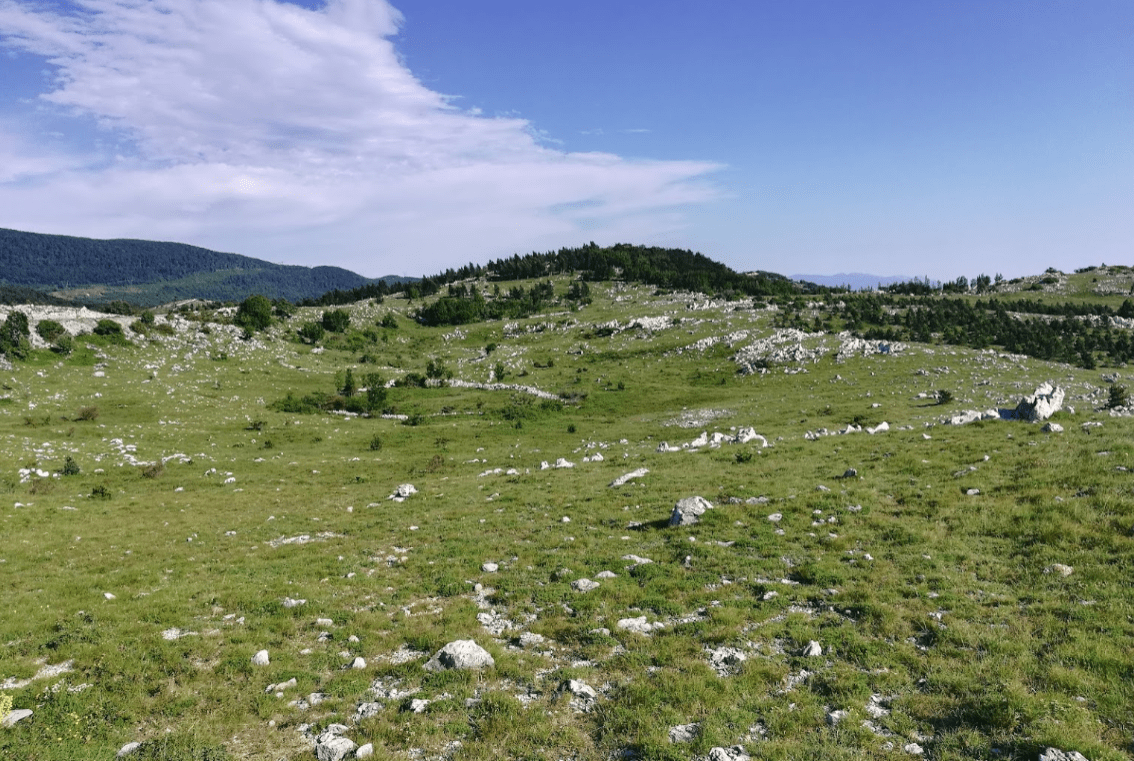 The archaeological site where evidence of the oldest domesticated dogs in Croatia was found is directly to the east of the modern city. You pass by the area of this former Neolithic settlement when you travel between the city and Zadar airport © Wikipedia
The archaeological site where evidence of the oldest domesticated dogs in Croatia was found is directly to the east of the modern city. You pass by the area of this former Neolithic settlement when you travel between the city and Zadar airport © Wikipedia
In their current forms, today's humans have existed for more than 40,000 years and dogs for about 14,500 years. The oldest evidence of modern domesticated dogs in Croatia come from remains found near Zadar. They have been dated to between 7500 and 8000 years old. There are six breeds of dogs that are today recognised as being indigenous to Croatia - Croatian sheepdog, Dalmatian, Istrian Coarse-haired Hound, Istrian Shorthaired Hound, Posavac Hound and the Tornjak. The vast majority of modern dog breeds originated over the last 200 years, so it is not clear if the oldest remains of dogs in Croatia are related to the indigenous breeds of today's dogs in Croatia.
“The question of why man and dog decided to coexist together is still not fully explained,” said Dr Novak to Vecernji List. “The relationship between man and dog is a very complex issue - this relationship is not one-way and most likely arose for mutual benefit, i.e. people realized the benefit they get from dogs and vice versa. The process most likely began about 25,000 years ago, and according to archaeological evidence, the process could have been completed approximately 14,500 years ago.”
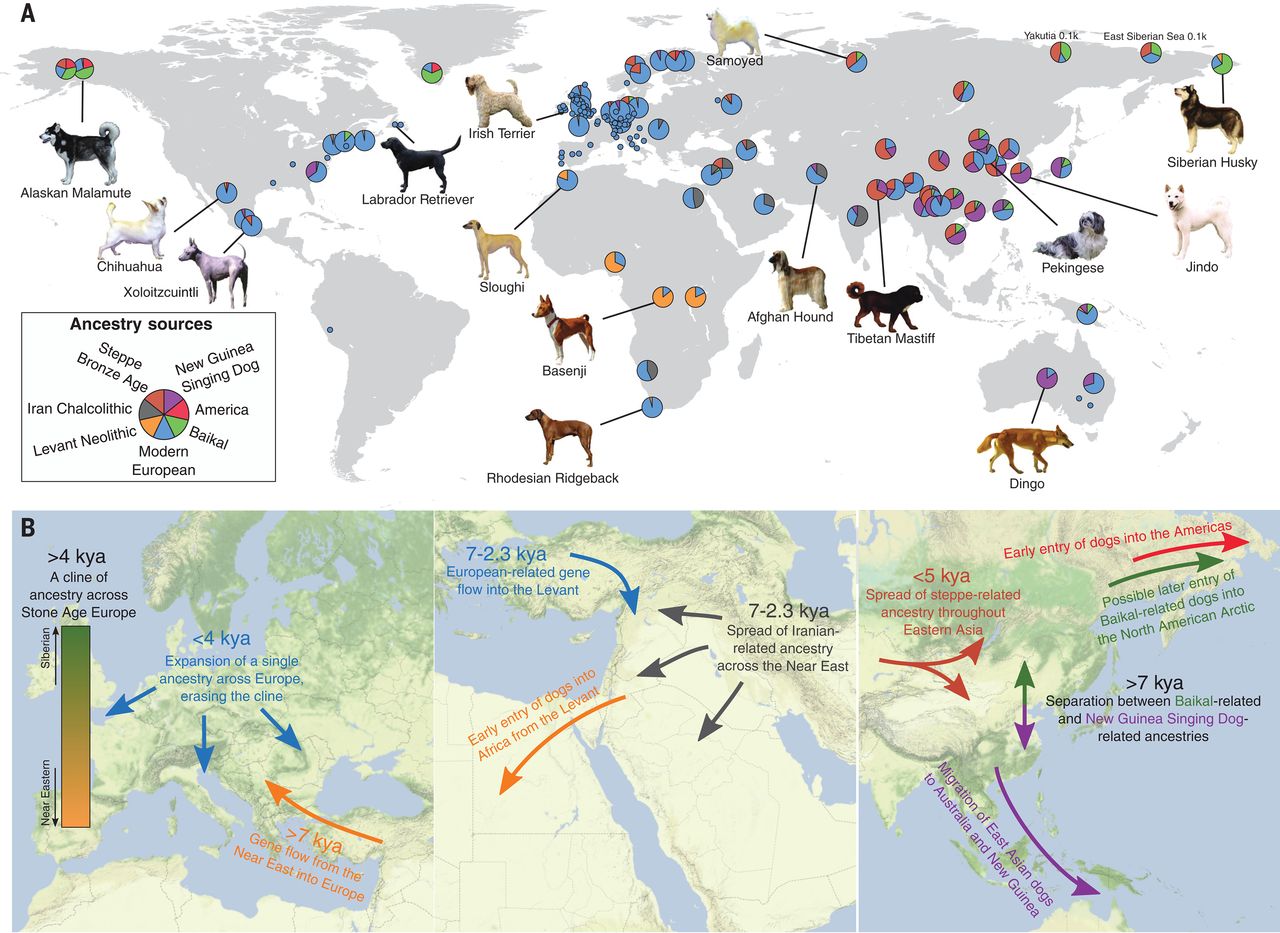 Graphic explaining ancestry of global dogs today, from the study
Graphic explaining ancestry of global dogs today, from the study
Dr Novak stated that the oldest evidence of modern domesticated dogs in Croatia comes from remains found in the Early Neolithic layer of the Crno vrilo archaeological site near Zadar. A fragment of the dog's lower jaw and two teeth from this site were dated to be approximately 7500-8000 years old. The ancient genomes of dogs in Croatia were sequenced for the first time in the Science journal study. One is from the Aljmaš - Podunavlje archaeological site, a Copper Age settlement (around 2600-2400 BC), the other from the site Sotin - Srednjea field, an older Copper Age settlement (around 3000-2900 BC).
For the latest travel info, bookmark our main travel info article, which is updated daily.
Read the Croatian Travel Update in your language - now available in 24 languages
VIDEO: Large Poskok Vipers Seen and Filmed in Vodice
October 26, 2020 – One of the largest Poskok vipers has been spotted in the area around Vodice, another was filmed hanging from a tree
Autumn in Croatia is the time of harvest, when the land gives up its bounty in preparation for winter and spring renewal. Those taking part in the harvest near the Dalmatian town of Vodice are sure to be extra vigilant over forthcoming days as local media has reported sightings of poskok vipers in the local.
One local resident detailed to infovodice.com that they had seen a specimen of almost 100cm in length. This is the maximum size an adult can reach (they are usually only around 85cm). Another of the poskok vipers was filmed hanging from a tree.
Vipera ammodytes is known as the poskok in Croatia. This species of viper is only found in southern Europe and parts of the Middle East. Although commonly called the sand viper, it actually prefers to live on dry, rocky hillsides with sparse vegetation, although it can be found on the edges of woodland and in woodland clearings.
The most northerly regions in which poskok vipers can be found are southern Austria, north-east Italy and Slovenia. They can be found as far east as Georgia, Syria and eastern Turkey. They are most commonly found within the countries of the Balkan peninsula.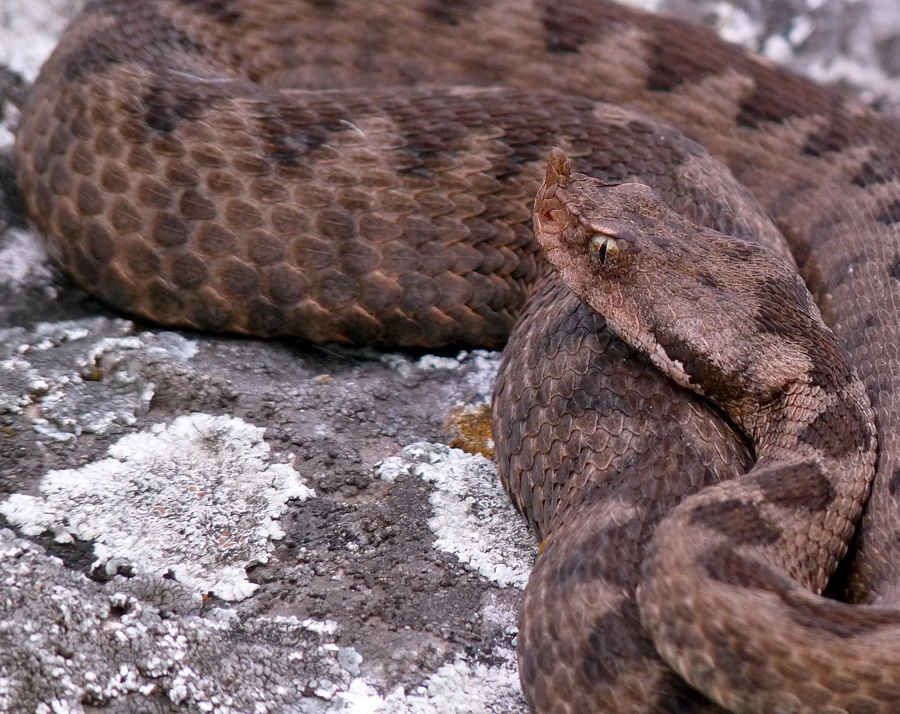 © Plamen Grigorov
© Plamen Grigorov
In Croatia, it's possible to find them living throughout Dalmatia and Istria, on the islands of Krk, Pag, Vir, Ugljan, Pašman, Korčula, Hvar, Brač and Mljet and in the continental regions of Lika, Medvednica, Žumberak, Banovina, Kordun, Gorski kotar, Kalnik, Zagora and Hrvatsko Zagorje.
Poskok vipers are a protected species in Croatia. Although they carry the deadliest venom of any snake to be found in Europe, they do not usually attack people unless provoked. However, they can be provoked unwittingly.
Depending on the region and the temperature, in the autumn months, the snakes can climb into trees. They do so to keep warm and to hunt for birds which, alongside small mammals and lizards, form the base of their diets. They hunt larger prey by first biting with their venom, then tracking the poisoned prey until it succumbs to the bite.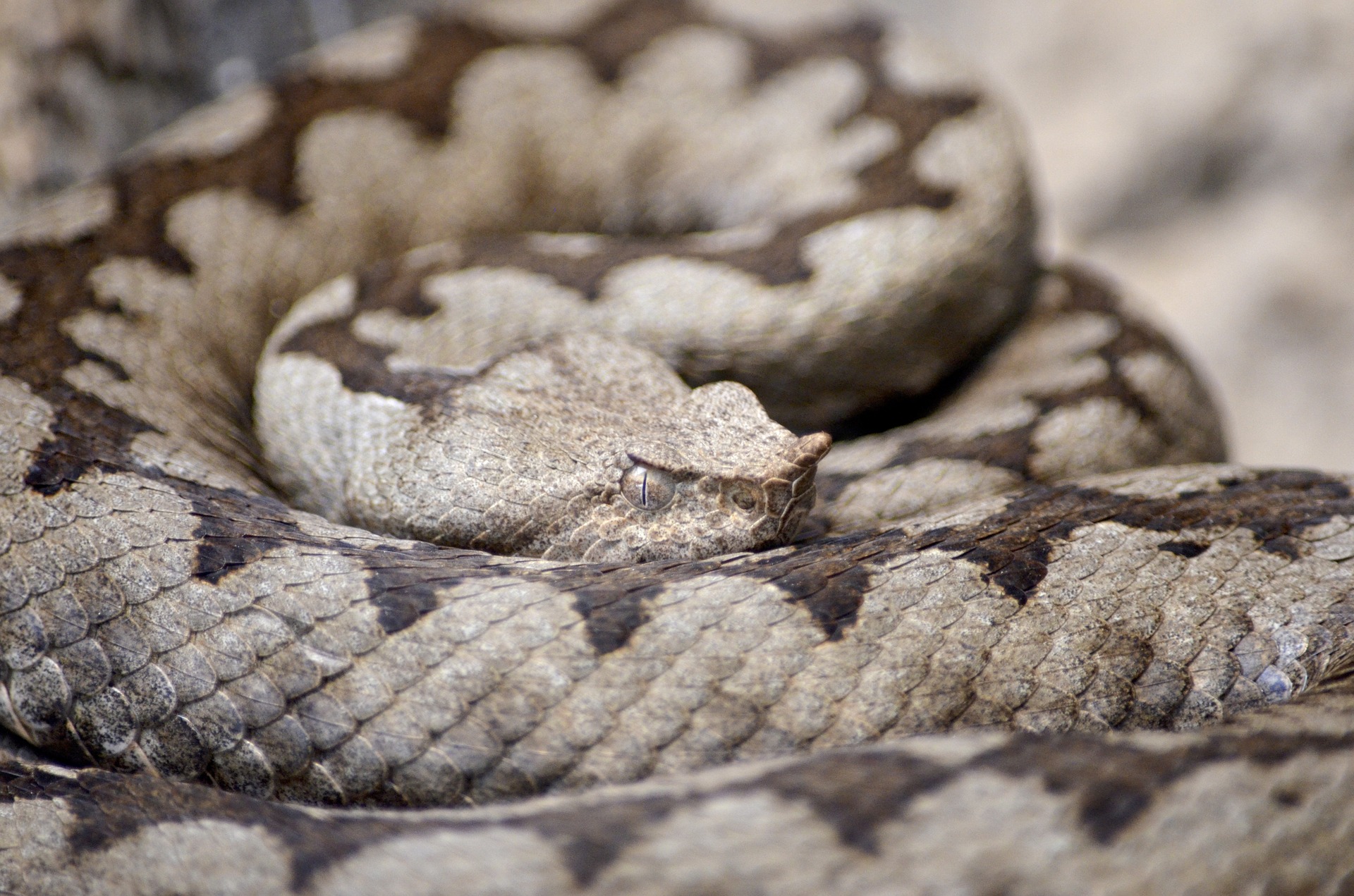 © Andrea Bohl
© Andrea Bohl
People are at particular risk to the vipers while they are in the trees as they can unknowingly walk close enough to the snake to make it feel threatened. Between August and the end of October, female poskok vipers give birth.
Poskok vipers can react unpredictably when they feel they are in danger. Some remain motionless and hiss loudly, some hiss and then flee, while still others will immediately attempt to bite. It is this unpredictability that gives poskok vipers their Croatian name – poskok meaning 'jumping' snake. The snake doesn't actually jump, but it can strike and bite faster than any other European snake. It coils itself over the back of its body and then throws its front towards its victim and has a considerable reach when doing so, of up to 40 centimetres.
On average, bites from poskok vipers account for around 25 hospitalisations each year in Croatia. Deaths occurring as a result of a bite are these days extremely rare. Although the snakes can be mistakenly disturbed in the autumn, the most common period for poskok bites on humans in Croatia is actually between May and June. The venom of poskok vipers is used to make antidote serum used to treat bites from all European vipers. Poskok vipers are farmed in some parts of Europe specifically for this purpose.
For the latest travel info, bookmark our main travel info article, which is updated daily.
Read the Croatian Travel Update in your language - now available in 24 languages.
Vukovar Student Becomes Croatia's First Animal Rights Lawyer
October 2, 2020 - Ivana Kramer from Vukovar became Croatia's first animal rights lawyer after graduating from the Faculty Of Law in Osijek
Ivana Kramer from Vukovar has become Croatia's first animal rights lawyer. She did so after graduating from the Faculty Of Law in Osijek, having received her diploma on September 23. The Faculty Of Law in Osijek is the only one in Croatia that has an elective course in animal rights.
In a recent interview with Vecernji List's Suzana Lepan Štefančić, Ivana explained that her desire to become Croatia's first animal rights lawyer stemmed from always having been around animals. “I have three dogs,” she said, in explaining her choice of the elective course in animal rights, “and my mother Željka adopts and helps abandoned animals.”
Some of the animals that Ivana's mum Željka looks after in Vukovar. Photos from the Facebook of Željka Kramer.
Ivana commuted to the Faculty Of Law in Osijek for five years in order to complete the course, choosing to stay living at home in Vukovar rather than move to the Slavonian capital. She says she would ideally like to stay in Vukovar to begin working in this field of law.
Her elective course in animal rights was undertaken in the final year of her studies and was the step that propelled her to the status of Croatia's first animal rights lawyer. During this final year, she researched the Animal Protection Act, which was implemented in 2017, with an emphasis on the situation in the Osijek-Baranja and Vukovar-Srijem counties. Her research included dog shelters in Vukovar and Osijek, where she occasionally volunteers.
For the latest travel info, bookmark our main travel info article, which is updated daily.
Read the Croatian Travel Update in your language - now available in 24 languages
VIDEO: Huge Whale Visits Croatia - This Summer's Second Sizeable Visitor
Tuesday, 8 September 2020 – Beyonce and Jay Z might be the biggest stars to visit Croatia this summer, but they're certainly not the biggest in size. In this stunning video, a huge whale visits Croatia
Croatia is never short of celebrity guests. This summer alone, the country's Adriatic shores and islands have been visited by Owen Wilson, Beyonce and Jay Z, and Lepa Brena and Lily Allen. But, such stars are dwarfed in comparison to the latest visitor.
A huge whale visits Croatia this week and its movements have been captured spectacularly by drone footage. In the video from the Blue World Institute, you can see the epic creature side-by-side with a fishing vessel. The boat is not small, yet it looks tiny next to this beast.
Video: A huge whale visits Croatia © Blue World Institute
Shots of this huge whale visits Croatia were taken by drone above the Velebit Channel in Dalmatia. It is not the first visitor of its kind this year. Earlier in the summer, the same Blue World Institute managed to grab some footage of a fin whale in the Adriatic (pictured below). Only last time, they didn't have their drone.
© Blue World Institute
The video was taken by the researchers on Saturday 5 September at the entrance to Novsko ždrilo. They followed the whale for about two hours, up to the Maslenica bridge where he turned back into the Velebit Channel and swam in the direction of Vinjerac.
The researchers took the video of this huge whale visits Croatia to analyze the size and health of the mammal. The footage allowed the researchers to determine that this was not the same animal they filmed in the same area in mid-August. When the whale swam close to their boat, researchers managed to obtain a small skin sample in order to perform a biopsy. They monitored the whale's progress and saw it again on the morning of Sunday 6 September, north of Novsko ždrilo.
For the latest travel info, bookmark our main travel info article, which is updated daily.
Read the Croatian Travel Update in your language - now available in 24 languages
Fastest Animal in the World Lives on Croatian Island of Jabuka
As Morski writes on the 1st of July, 2019, this strange little island is uninhabited and volcanic. Close to the islands of Brusnik and Svetac, the Croatian island of Jabuka (which translates to Apple) was known for its falcon hunting lodge throughout history.
According to old records, hunting was conducted during autumn, more precisely in September. Back in 1603, Francis Castela said that at the foot of the island there was once a small cottage where the hunters stayed while they were spending time visited nests located out on Jabuka's sheer and daunting cliffs and rocks. He pointed out the fact that climbing on the island of Jabuka was extremely difficult, but facing fears and exposing yourself to these dangers could sometimes pay off very well.
A Portuguese man once wrote that some Venetian nobleman earned a considerable amount of wealth each and every year for selling the birds that were born, raised, and lived on Jabuka.
The Hvar Commune once wrote in favour of hunting the island's resident falcons, and the proper skill of hunting on Jabuka was probably initially brought about by the Benedictines, according to Podvodni.hr.
In 1516, four hunters (probably from the island of Vis) took a smaller boat and secretly went to Jabuka to try to capture the island's falcons and make good money from them. Upon arrival, a storm broke, easily wrecking their poorly moored boat and the four men remained on the island of Jabuka, cut off from the rest of the world without food and water. Since nobody knew about their intentions, nobody even bothered to search for them in such an unlikely places as Jabuka, and all four men eventually died of hunger and thirst.
The Peregrine falcon (Falco Peregrinus), known for being the fastest animal in the world, still nests on Jabuka for this day, and they even go as far as to attack visiting drones trying to capture some beautiful snapshots of the island.
The beautiful Peregrine falcon is an absolute world record holder when it comes to speed, possessing the ability to fly at a speed that can reach over 300 km/h. These falcons are not only the fastest bird in the world, but are also considered to be the fastest animal in the world.
Make sure to follow our dedicated lifestyle page for much more.


